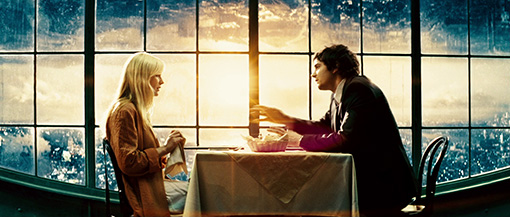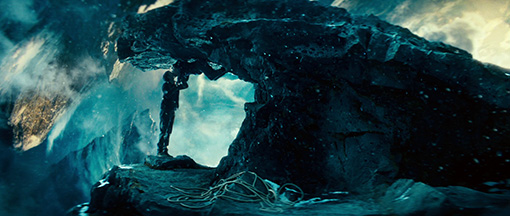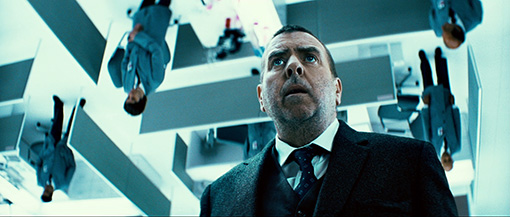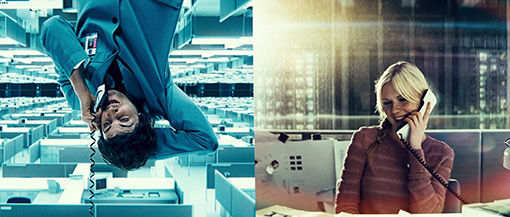|
Argentine filmmaker Juan Solanas' mind-bending leap from short film Oscar nominee to big budget feature imaginer is a boldly original high concept that's visually vibrant but sadly, fails to wow in any of the ways you wish it would.
A science fiction, star-crossed courtship between Eden (Kirsten Dunst) and Adam (Jim Sturgess) sees the lovers overcoming society and the laws of physics to be together. Existing in a solar system with double gravity, Adam and Eden's twin planets orbit the same sun in a world where it's possible to fall up and rise down depending on your perspective. A binary reflection that's the farthest thing from a mirror image, the gleaming lights of prosperous, just-out-of-reach Transworld shine down tauntingly on the struggling citizens of Down Below, a poverty stricken land of soot and ash without electricity. Looming large in every frame of the film, this persuasively Dickensian dystopia remains bizarrely divorced from the D.O.A. love affair at the film's centre. Their amour lacking anything substantive or subtextual, more politically charged pining would have positioned Adam and Eve as an "us against the world(s)" couple, elevating the emotional stakes and audience investment. It's indicative of how under-developed the romance of this over-plotted film is, that the onset of Eden suffering sudden amnesia is treated so spuriously. Just another first act obstacle to keep the lovers apart, the sadness and heartache of how the condition affects both parties is never addressed and just like a forgotten memory, it's dumped altogether when it no longer feels dramatically urgent.

Three fundamental laws of double gravity govern this particular universe. One in particular is loaded with dramatic urgency. All matter is bound to the world from which it hails, so Adam visits Transworld (right side up) by offsetting Down Below's gravity with inverse matter from the other world concealed on his person. The hitch is that as time passes, the inverse matter becomes combustible and starts burning through his clothes. The second Adam dumps what scolds and holds him in Transworld, he's pulled back into his own gravity. There's an expectation for a suitably thrilling set piece the moment this is laid out and none too surprisingly, it provides the set-up for the film's one truly memorable sequence. Prolonging a near-perfect date with Eden a moment too long, Adam says his goodbyes as he's literally going up in smoke. Dashing through the city, he hurls himself into the ocean and in one incredibly seamless sustained shot, we watch agog as he's sucked back up out of the water and hurled through space into the next atmosphere.
For all it's sumptuous symmetry, with frames in every scene that you might want to hang on a wall, Solanas gets so bogged down with the fundamentally silly science supporting the sweep of his outsized visuals that character is only ever an afterthought. It's all too easy to zone out (as I did both times watching the film) with all the yakking about upper and lower inversions and hyper infusion. When they're not trying to illuminate convoluted, sketchy science, Dunst and Sturgess spend their time making gooey, green screen eyes at one another and it's never enough to makes us believe in a love that defies two atmospheres and spans their entire lives.

When Adam and Eden fall in love as children, reaching out to one another from respective mountain peaks almost touching, the widescreen divide of just a few feet feels positively enormous. It's a mystically astonishing image that came to Solanas in a dream and was the inspiration for his film, but any sense of majesty is consistently undermined by Adam's breathy, intrusive, voiceover. Talking about ridiculous flying pancakes and the pollen of pink bees with such awestruck reverence you feel as though you're listening to Keanu Reeves' audition tape for a Malick movie, that same kind of stupefied "whoa" translates to the performances. When he enters Transworld for the first time you can see Sturgess oscillating between wide-eyed wonder and even wider-eyed wonder as he takes in all the tennis balls standing in for opulent, monolithic buildings on the green screen stage where the scene was no doubt shot.
These approaches are nigglingly problematic but the sheer amount of exposition-dumping in the first five minutes explaining the three basic laws of double gravity stands as the film's nadir; a da Vinci-style diagram, power point presentation thrown on screen with interminable narration. It's made all the worse after watching the special features, in which we learn of an epic, century-spanning opening sequence which would have shown all this rather than told. Upside Down has the distinction of being one of the most expensive Spanish co-productions ever mounted, but not it would seem, expensive enough by Hollywood standards to fully justify its high concept.
This would-be magical realist fairy tale can at least boast of offering something we've never seen before, so from that perspective it's easy to recommend making an evening of it and simply enjoying the spectacle. A pity then, that like much spectacle, (Hollywood or otherwise) it crucially lacks human purpose. The film's lavishly rendered craftsmanship is so aggressively pre-vized, it tends to favour the immaculate over the visceral. Together, Dunst and Sturgess are as beautiful as the film around them (Dunst more so than ever before), but as actors they've given little to do and we the audience, even less to care about.
Note that the comments below refer only to the 2D version of the film.
Research suggests that Upside Down was shot on Arricam V-Lite cameras with V-Plus Lenses, which means it originated on 35mm, an increasingly rare thing in these all-digital days. Given the genre, it's perhaps not surprising that the picture has undergone some major post-production tinkering, heavily tinting some scenes and tweaking the colours, contrast and image in general on others. This, coupled with some visible film grain, results in an image that’s not as super-crisp as you might expect, having more of an indie than a Hollywood look. With this proviso in mind, this is still a very strong and pleasingly consistent transfer, with a good level of detail, crisp black levels and vivid reproduction of the stylized colour scheme. Pierre Gill's handsome scope cinematography is well served here.

The Dolby 5.1 True HD surround soundtrack is consistently excellent, making rich and inclusive use of the full sound stage for effects and music and some really punchy LFE bass. The centre-weighted dialogue is never lost in the mix. A Dolby 2.0 stereo track is also included, and while clean and clear, it does not have the fullness and range of the HD track.
The Making Of (3D, 25:10)
It starts with the original concept, which came from a dream Solanas had of two mountains, their peaks touching. Producers, principal crew members and actors talk about the technical challenges of bringing that concept to life but we never see enough of what that entails practically, besides tantalizing glimpses of elaborately constructed sets augmented with green screen enclosures and actors on complex wire rigs. Running twenty-five minutes, it's a disappointingly insubstantial peak behind the scenes. That's not to say that some of the more spectacular sequences and images aren't discussed in very specific detail. You do come away with a general sense of what an ambitiously challenging project this was, but only a rudimentary sense of how those challenges were overcome. One of the highlights is seeing an entire set moving 360 degrees on a gimble in synch with the camera. We also get much talk about how head scratching the film's production was for every crew member. How you have to constantly be thinking about what gravity you're in and how it affects you. For example, whenever Eden visits the down world it was important that her hair was tied back so it's not constantly flying up in the air, making it impossible to concentrate on anything but that. The crew's achievement is impressive, essentially shooting two movies in two sets: the floor of one world, the roof of another. Maintaining continuity on angles and character action was understandably, hellishly impossible for everyone involved and for the actors, they often had as many as five different as they moved around the room, interacting with characters from both worlds.
Deleted Scenes (3D, 1:45)
An extension of the scene where Adam preps his gear in order to go to Transworld and a small moment of Timothy Spall's helpful sidekick character perfecting the inverse-matter formula – in both scenes the VFX are unfinished with the actors visibly on wires.

History of the World (3D, 2:46)
The film's original title sequence in which the prehistoric men of each orbit exchange ideas of mathematics and geometry, in the process discovering the three laws of double gravity. An interesting aside posits an amusing quackpot theory of how the pyramids were built. Commerce and harmony between the worlds later led to war, a divide that becomes manifest the moment Uptop discovers electricity. Budgetary considerations no doubt scuppered this ambitious opening, but even from the storyboards it looks so much more exciting to learn about the laws of gravity as characters test them, rather than a Jim Sturgess lecture with overdesigned graphics
Juan and Jim (3D, 0:17):
Pointlessly nonsensical mobile phone footage shot with an old movie stock app of Strugess and Solanas on set.
Preliminary Sketches (3D)
Conceptual drawings that look even more impressive and sumptuous than the finished film due to the noted absence of aggressive colour grading, post production teal pushing and unnecessary use of the patented J.J. Abrams lens flare.
Tango Storyboards (3D, 1:41)
One of the film's most visually impressive sequences plays out with accompanying story boards appearing in the top right-hand corner of the screen.
Missing Forest Storyboards (3D, 1:51)
Juan Solanas comments over an abandoned action sequence, presumably due to funds (remember, the most expensive Spanish production is spare change to Hollywood). The sequence looks exciting and incredibly stunt heavy. You can hear how disappointed Solanas is not to have shot it, especially given that Strugess trained extensively in preparation.

Sage Mountain Previz (3D, 2:51): Juan Solanas speaks over a sequence that could not have been attempted without previsualizatiion.
Office Previz (3D, 3:01):
Solanas speaks of the nightmare of preparation for the scene in which Adam gets a job at Transworld, one office haning over the other with a legion of background actors upside down.
Final Shot Previz (3D, 2:55): Solanas storyboards a basic 3D model on his own laptop, before a more complicated previz with detailed geometry is mapped out with the special effects team. The final shot on a set is then extended in 3D, with the cityscape as the camera pulls out entirely created in the computer. Solanas stresses the artistic nature of such a process, that it's not just about putting the pixels in order.
Previews
Trailers for other Millennium titles.
A sci-fi romance that's all high concept and very little heart, it just about works on the strength of the brain-bending big screen visuals, the fresh-faced beauty of Kirsten Dunst and the originality of it's concept. Extras are plentiful if not quite as in-depth as they might be, but Solanas is a good speaker and I would have gladly listened to a commentary track from him. Recommended if you're looking to show off your home cinema.
|